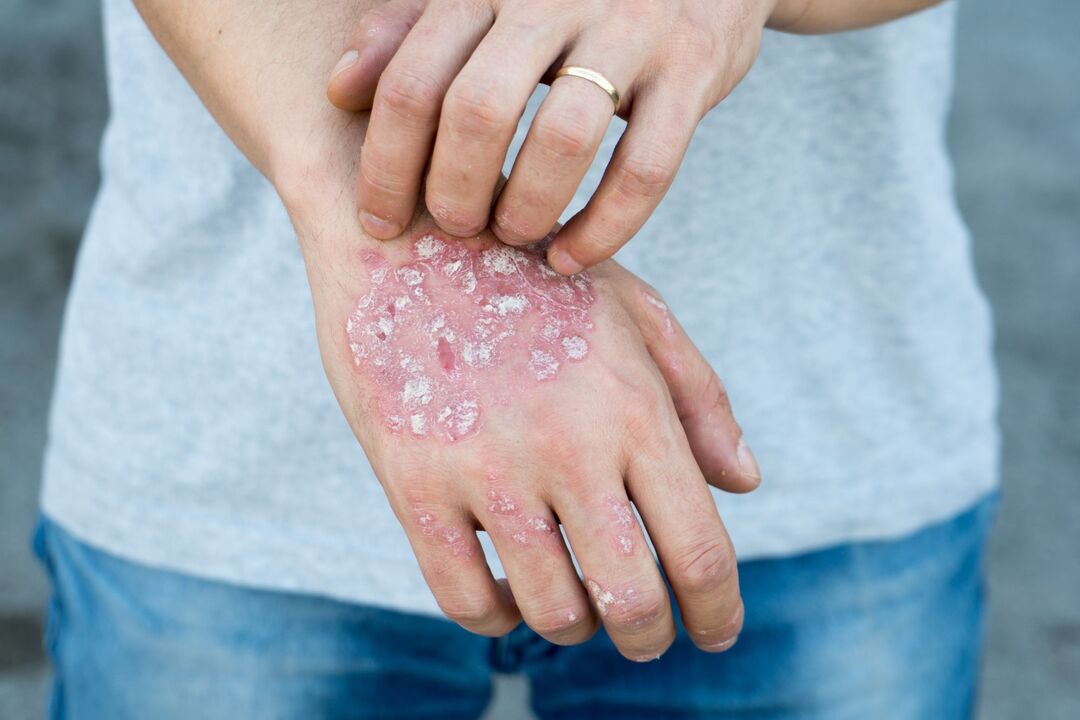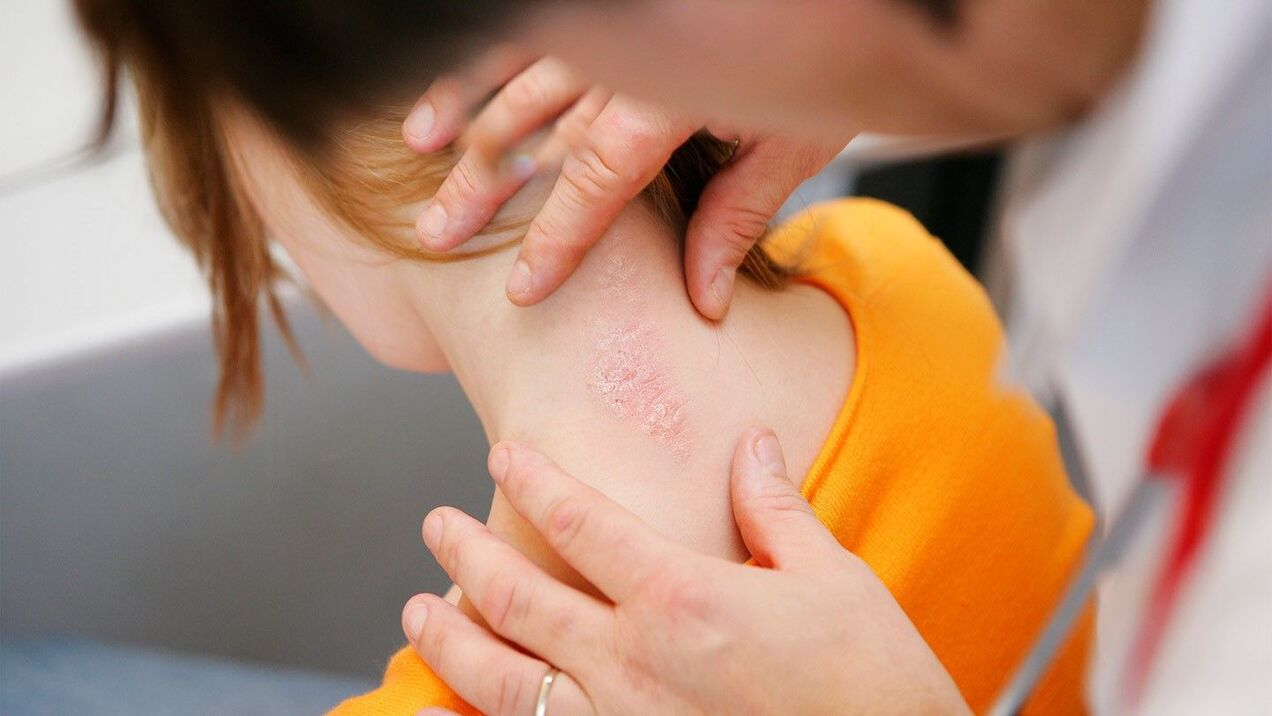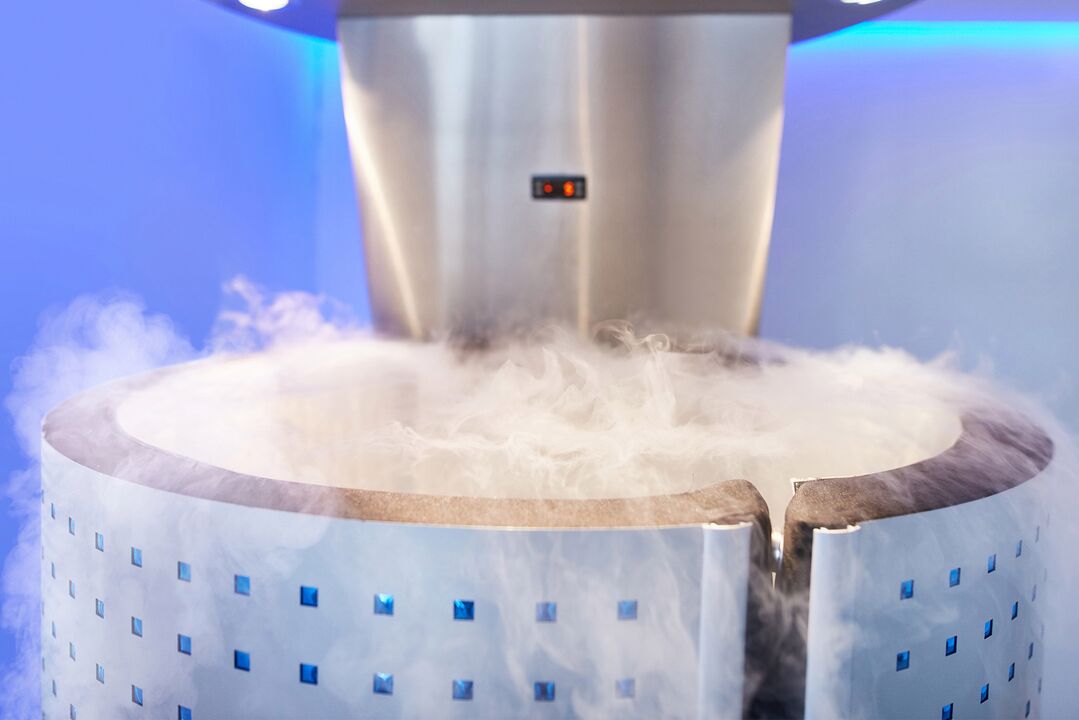Psoriasis is one of the most common skin diseases.According to the International Federation of Psoriasis Associations (IFPA), the disease is found in 125 million people worldwide.
In most cases, the disease develops in people of working age: from 15 to 35 years old.Men and women get sick equally often.Although this disease is widespread, not all patients understand what psoriasis is, why it occurs, and how to treat it.Let's tackle all the questions in order.
Briefly about the main thing

Psoriasis is a chronic inflammatory disease of an autoimmune nature, characterized by the formation of specific “plaques” on the skin.Autoimmunity involves the production of protective antibodies against the body's own cells, which the body mistakes for foreign objects.Scientists have long established a link between this disease and activation of the immune system, but the exact cause of the failure to recognize one's own cells has not been reliably clarified.
A genetic factor for psoriasis has been proven: if both parents have the disease, the child has a 50% risk of developing psoriasis.Even some genes responsible for its development have been identified.In addition, the influence of hormonal disorders, nervous stress, metabolic disorders and viral infections on the manifestation of psoriasis lesions in the body has been determined.
Psoriasis in many cases is combined with diseases of other organs and systems:
- type 2 diabetes;
- metabolic syndrome;
- pathology of the liver and biliary tract;
- coronary heart disease;
- arterial hypertension.
Classification and symptoms of psoriasis
The main clinical manifestations of the disease depend on its form and course.

- Psoriasis vulgaris: a characteristic rash appears on the skin, which looks like raised red areas on its surface (called papules) with superficial peeling.As a result, white scales appear, due to which psoriasis got its second name - scaly lichen.If you scrape the area, you may see the “stearin stain phenomenon” – the number of scabs will increase, like a drop of frozen stearin.After complete removal of the scales, a shiny, moist end plate will be revealed, on which, upon further scraping, small drops of blood will appear.Such papules are often located on the scalp, on the extensor surfaces of the joints.
- Exudative psoriasis: an inflammatory fluid is secreted in the inflamed area, wetting the scales, turning them into crusts that are difficult to remove.
- Seborrheic psoriasis often occurs in areas of the skin with many sebaceous glands: nasolabial folds, scalp, area between shoulder blades and on the chest.In this variant, severely itchy patches with yellow scales are formed.
- The teardrop shape is commonly seen in children and appears as many small red, slightly peeling papules.
- Pustular psoriasis is a type of superficial pustules, often located on the palms of the hands and soles of the feet.
- Generalized forms: erythema psoriatic, manifested by widespread focal foci, covering 90% of the body surface, and Tsumbusch psoriasis, accompanied by suppuration of extensive foci.With common forms of the disease, general health is also affected: weakness, irritability appear, body temperature increases.
- Psoriatic arthritis is characterized by redness and swelling of the skin over the joints, pain, limited movement in the joints, deformity and stiffness when moving after sleep.
- Psoriatic nail dystrophy is a lesion of the nails.Characteristics are “oil stain symptom” (yellow-brown spots under the nail) and “thimble symptom” (point lesion on the nail).
How is psoriasis treated?

Psoriasis treatment methods are constantly being improved and supplemented, but there is no medicine that can defeat this disease forever.Therefore, the main treatment strategies for psoriasis aim to:
- reduces the frequency of exacerbations;
- reduce symptoms of the disease;
- improve quality of life;
- reduces the likelihood of complications and associated diseases.
Treatment is usually performed on an outpatient basis, but some conditions may require hospitalization:
- severe generalized variants of psoriasis, worsening of the patient's general condition (especially erythematous and pustular psoriasis);
- the presence of complications and concomitant pathologies that aggravate the patient's condition;
- The need to use drugs requires regular monitoring of clinical and laboratory parameters.
In the treatment of psoriasis, both local and systemic agents are used.
On-site treatment
This type of treatment is represented by ointments, gels, creams that are applied directly to the affected area.
Topical glucocorticoids
These are hormonal drugs that have an anti-inflammatory effect on the skin.In addition, the hormone reduces itching, suppresses the immune response, reduces the spread of the inflammatory process and prevents the fusion of lesions.These drugs are very effective, as proven by many studies.They can be used separately (for local forms) or in combination with other means.
This group includes flucinar, hydrocortisone, elocom, prednisolone, advantan, acriderm.Topical glucocorticosteroids are available in cream, ointment, and topical forms.
The disadvantage of these drugs is the risk of developing systemic (whole body) effects with prolonged use and a large area of exposure.Here are the rules for using these drugs:
- Use only in the shortest possible courses.
- When infection occurs, glucocorticoids should be used in combination with antibiotics or antifungals.
- Children should not apply hormones to their face, neck, or skin folds.
- It is better to start treating the child with drugs with weak or moderate activity (prednisolone, hydrocortisone).
As a rule, hormonal agents are applied to psoriatic papules 1-2 times a day for up to 1 month.With long-term use, adverse reactions may occur:
- burning, redness, and itching;
- appearance of acne;
- local infection;
- thin, dry skin;
- reduced pigmentation;
- stripes.
The face and groin area are most often affected by complications.
Salicylic acid
Used in combination with topical glucocorticosteroids for significant skin peeling.Preparations containing salicylates (diprosalic, acriderm SK, elokom S) effectively remove peeling patches and help restore the skin.
Vitamin therapy

Vitamin D is an effective treatment for localized forms of psoriasis, as it reduces inflammation and excessive skin cell division.Cream or ointment containing vitamin D3 (calcipotriol, davonex, calcitriene) is applied to the plaque 1-2 times a day for about 2 months.Do not treat large areas of skin with them.Can be used in combination with glucocorticoid hormones.
Adverse reactions to topical application of vitamin D3 are rare and mainly manifest as a burning sensation, redness and itching of the skin.In this case, I either interrupt the course of treatment or use the ointment less often.In case of overdose, systemic manifestations of vitamin D excess may occur: decreased bone density and kidney stone formation.
Drugs in this group are not prescribed before starting ultraviolet therapy.
You cannot simultaneously use drugs based on salicylic acid analogues and external vitamin D - this will lead to inactivation of the latter and significantly reduce the effectiveness of treatment.
zinc pyrithione
Preparations of this type (skin-cap, zinocap) are produced in the form of creams, sprays and shampoos.They are used not only to treat psoriasis but also to prevent recurrence.The mechanism of action is antibacterial, antifungal activity and slowing of cell division.The drug can cause allergies, dryness and skin irritation when used repeatedly.Therefore, the course of treatment should not last more than 1.5 months.
Systemic therapy
This treatment option involves using medication in pill or injection form;they affect not only the integumentary tissues but also the internal organs.Systemic treatment is used for moderate to severe psoriasis.
methotrexate
A drug belonging to the group of cytostatic drugs that prevents cell division.It is prescribed for psoriatic arthritis, erythroderma, pustular and pustular psoriasis, if it does not respond to other types of therapy.
The dose of methotrexate is selected individually, taken once or several times a week.After the exacerbation subsides, the drug continues to be administered at the minimum effective dose.Medications often cause side effects, so this treatment requires constant medical supervision.Possible adverse reactions:
- decreased number of all blood cells;
- appetite suppression, nausea, vomiting;
- the formation of ulcers and erosions in any part of the digestive system;
- damage to the liver and pancreas;
- headache, drowsiness, seizures;
- visual disturbances;
- kidney dysfunction;
- Inhibits germ cell formation;
- decreased sexual desire;
- joint and muscle pain;
- non-infectious pneumonia;
- allergic reaction.
The medication will be discontinued if severe difficulty breathing, coughing, development of serious infectious diseases, anemia, or significant increases in blood markers of kidney or liver failure occur.
Cyclosporine
A drug that inhibits the function of the immune system.Considering the autoimmune nature of psoriasis, this therapy is reasonable, however, a general decline in immunity often leads to infectious and cancerous complications.Therefore, the drug is rarely used as maintenance therapy but is only prescribed during an exacerbation.Start taking cyclosporine with the minimum dose, then gradually increase it until the desired results are achieved.
Adverse reactions of cyclosporine:
- impaired kidney function, swelling, increased blood pressure;
- toxic effects on the liver and pancreas, nausea, loose stools;
- formation of malignant tumors and lymphomas;
- decreased blood cell count;
- muscle pain, cramps;
- headache;
- allergy.
The use of cyclosporine requires constant medical supervision, regular blood tests and other necessary tests.
Retinoids
Retinoids (acitretin, isotretinoin) are vitamin A derivatives that normalize the division and keratinization of skin cells.The course of treatment with these drugs is on average 2 months, the dosage is selected individually.When using retinoids, there is also a risk of certain unwanted reactions:
- drying of mucous membranes;
- skin peeling;
- fungal vulvovaginitis;
- hair loss, thin, brittle nails;
- muscle and joint pain;
- hepatitis, jaundice;
- nausea, stool disorders.
Although there may be side effects, these medications are safer than previous options, especially because all of these complications are reversible and disappear some time after stopping the medication.Retinoids should not be prescribed concurrently with methotrexate as this increases the risk of structural liver damage.
Monoclonal antibodies
Monoclonal antibodies (Infliximab, adalimumab, efalizumab) are biological products of genetic engineering as antibodies.They have the ability to suppress autoimmune processes and reduce inflammation.These medications are administered subcutaneously or intravenously no more than once a week.Their negative effects on the body are mainly associated with the suppression of the immune response:
- the addition of infection of any localization;
- Benign and malignant tumors;
- allergic manifestations;
- headache, dizziness;
- depression;
- nausea, vomiting;
- joint and muscle pain.
The use of drugs of this group is possible in combination with methotrexate.
Systemic glucocorticoids
Systemic glucocorticoids (prednisolone, dexamethasone) are used exclusively in the treatment of psoriatic arthritis and acute systemic forms of the disease by injection and drip.But even in these cases, hormonal treatment should not be prolonged due to the risk of aggravating the process and developing pustular forms.
Treatment with complementary medicine
This group includes drugs needed to correct concurrent conditions that aggravate psoriasis and treat arthritic forms of the disease.
- Psychotropic drugs are used due to the high frequency of exacerbations of psoriasis in the setting of unstable neurological status.In particular, antidepressants (amitriptyline, fluoxetine, venlafaxine) and anti-anxiety drugs - sedatives (diazepam, phenazepam, buspirone) are prescribed.Antidepressants are often prescribed for long-term depression and stress and are used on a long-term basis.Sedatives can be administered once, as required, depending on external circumstances.This group of drugs suppresses anxiety, agitation, susceptibility to stress factors and normalizes sleep.However, it should be noted that the drug also has contraindications for use and side effects, which do not always allow simultaneous use with the main therapy of psoriasis.
- Nonsteroidal anti-inflammatory drugs are used in the complex therapy of psoriatic arthritis to reduce the inflammatory reaction, swelling and pain.These products are produced in the form of tablets, injectable solutions, gels and ointments for external use.Due to the negative effect on the digestive tract (ulcer formation), these drugs are prescribed for the shortest possible time.
- Antihistamines are sometimes used to relieve itchy skin.Prescription drugs are first generation (Tavegil, Suprastin), second generation (Fenistil, Claritin) or third generation (Zyrtec, Erius).The effectiveness of these drugs is largely equivalent, however, third generation drugs do not have the common side effect of antihistamines of increased drowsiness.
Physical therapy for psoriasis
Ultraviolet radiation (UVR) involves exposure to radiation with wavelengths of 311-313 nm over the entire body or on individual parts of the body.This technique cannot be applied to severe forms of systemic psoriasis and summer forms of psoriasis, as it can only aggravate the process.
Selective phototherapy (PUVA therapy) is a type of ultraviolet radiation, but the wavelength used in this case is 310–340 nm.This physical therapy option, when used regularly, will allow you to achieve lasting relief.A treatment session can last up to 2 hours and the recommended total is 35. After the procedure, dry skin may appear and the use of a moisturizer may be required.PUVA therapy has some contraindications, such as kidney failure, diabetes mellitus, and skin tumors.
X-ray therapy involves treating the skin with soft X-rays, which effectively combats itching and the formation of new plaques.
Ultrasound treatment involves exposing the skin to ultrasound waves, which have anti-inflammatory, antibacterial, analgesic and anti-itch effects.The procedure lasts 15 minutes, causes no discomfort and is well tolerated.A total of 14 procedures should be performed.
Electrosleep indirectly affects the course of psoriasis, improving the patient's mental state.This operation has a calming effect, improves sleep, increases resistance to stress and reduces excessive excitement of the nervous system.One session can last up to 1 hour, it is recommended to perform at least 10 procedures.
Psychotherapy
The role of unstable mental state in the development of psoriasis has been proven by many studies.Stress, anxiety, fear and various experiences often trigger the appearance or exacerbation of psoriasis in people with a genetic predisposition.Therefore, psychotherapy is important for preventing exacerbations and generally reducing the frequency of relapses.
During the examination, the specialist talks with the patient, asks leading questions and tries to determine the cause of psychological problems.Subsequent sessions are aimed at stabilizing the patient's emotional state.A psychotherapist can teach you how to cope with stress at work and at home, find an outlet for negative energy, and develop a positive attitude toward yourself and the world around you.
Nutritional treatment of psoriasis
Patients with psoriasis are advised to:
- Drink more water: 7-10 glasses of water or freshly squeezed juice every day.
- Eat lots of fruits and vegetables: grapes, nectarines, cherries, pineapples;beets, carrots, cucumbers, cabbage, garlic, onions, dill, fennel.
- Don't forget the protein component in your diet: eggs, lean meat, nuts, beans.
- Only natural sweets: dried apricots, dates, raisins.
- Do not abuse citrus fruits, tomatoes, red bell peppers, strawberries, and honey.
- Avoid chocolate and high-fat whole milk.
- Do not drink alcohol, caffeine, spicy, salty or smoked foods.
Alternative methods to fight psoriasis

- Cryotherapy is the impact on the body of extremely low temperatures, which can be local and systemic.The mechanism for improving psoriasis is the body's short-term stress response to cold.In that context, blood vessels narrow rapidly and then dilate, leading to increased blood flow and reduced inflammation.In addition, low temperatures significantly slow down the speed of nerve impulses and prevent the formation of new lesions.Conventional cryotherapy is performed using a special cold chamber in which a person can stay for no more than 3 minutes.The temperature in there is set in the range of -110 – -130°C.The entire course should not exceed 30 procedures.Local cryotherapy is performed by exposing the skin area with psoriatic plaques to liquid nitrogen vapor (temperature -140 – -160°C).During research, it was noticed that after a course of treatment, psoriatic papules turned pale, decreased in size, peeling and itching disappeared.
- Hydrotherapy is widely used in sanatoriums with hot water.Garra rufa fish living in such waters eat rough particles and scales on the surface of the skin, leaving healthy skin areas unaffected.
- Plasmapheresis is a rather complex process that includes taking blood from the patient's body, purifying it of toxins, immune complexes, microorganisms and returning it to the general bloodstream.A special centrifuge is used to filter the blood.The positive effect of plasmapheresis in psoriasis is associated with the removal from the blood of immune complexes that support autoimmune reactions, decomposition products formed as a result of chronic inflammation, as well as microorganisms and their toxins when secondary infections occur.
- Mud therapy is an effective method to help improve the health of psoriasis patients.Due to its significant mineral salt content, therapeutic mud works to prevent inflammation, promote tissue regeneration and soften rough skin areas.Mud therapy allows you to achieve better results in the treatment of psoriatic arthritis.Before applying to the skin, the mud is heated to 39°C, then spread a thin layer on areas with plaque and left for 30 minutes.At the end of the procedure, dirt is washed off with warm water and the skin is lubricated with an emollient cream.
Traditional medicine formula for psoriasis
Folk remedies for the treatment of psoriasis fall into two groups: oral preparations and external treatments.The first type includes:
- Tincture of celandine.Herbs of this plant can be found at the pharmacy.2 tbsp.I.Dry herbs are poured with 500 ml of wine or vodka and left to brew for 10-14 days.Then the tincture is filtered and taken 20 g 3 times a day.
- Bay leaf decoction.Put 15 bay leaves in 1 liter of boiling water and boil for about a quarter of an hour.Then filter, cool and drink 1 tablespoon.I.3 times a day for 1 month.
- Cumin seeds.2 tbsp.I.Seeds, pour 1 glass of boiling water, brew for about three hours, filter, drink ½ cup 2 times a day.
- Flax seeds.1 tbsp.I.seeds, pour a cup of boiling water, stir well, leave overnight, drink in the morning, before breakfast.
Traditional medicine externally treats psoriasis:
- Fish oil.Apply a thin layer on pimples and leave for half an hour, then rinse with warm water.
- Flaxseed oil.Apply to affected area up to 6 times a day.
- Egg ointment.Beat 2 eggs, add 1 tablespoon.I.sea buckthorn or sesame oil and 40 g of vinegar.Lubricate the patches 3 times a day.
- Propolis ointment.30 g of propolis and 50 g of tar are heated in a water bath and stirred well.Apply for psoriatic rashes up to 4 times a day.
It should be noted that no matter what alternative and folk remedies you use in the treatment of psoriasis, they should not replace the main traditional therapy.All medications used to treat psoriasis must be strictly prescribed by a doctor.In any case, you should not self-treat or change the dosage and medication regimen at will.

























